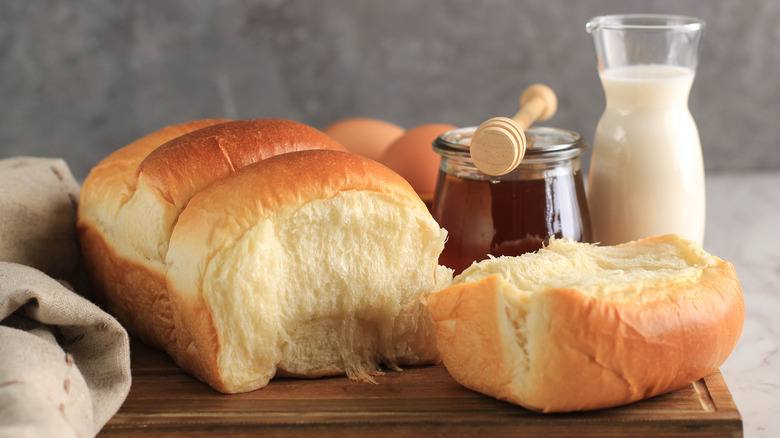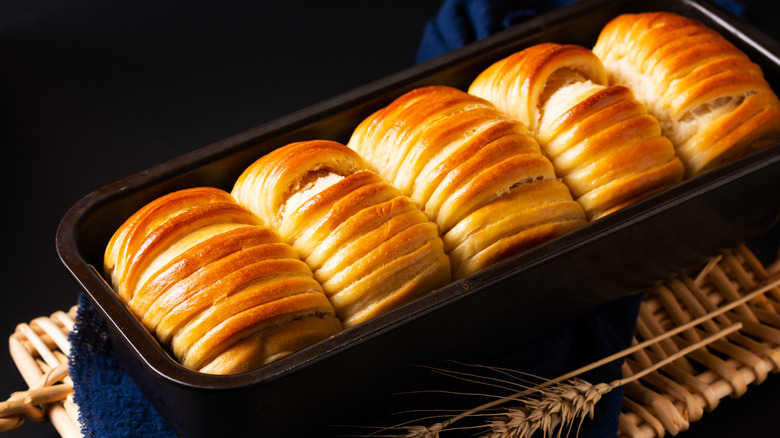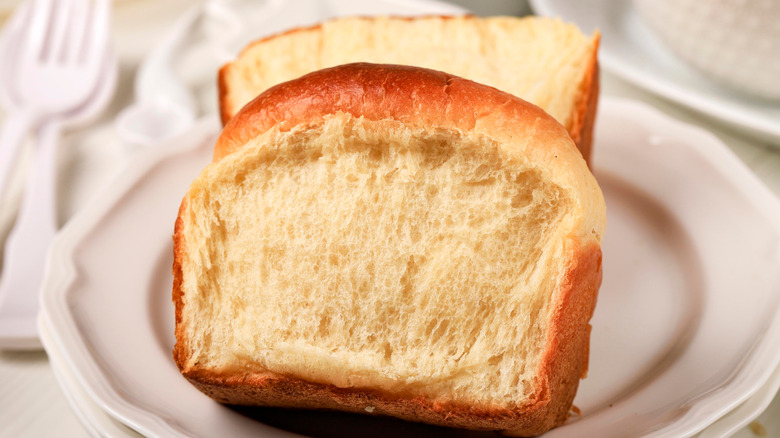Pai Bao Is The Long-Lasting Fluffy Bread You Need To Try ASAP
If you've ever tried a bao bun, you're in the general ballpark of its super-sweet cousin, the pai bao. But rather than being a filled or dumpling-like bun, this is a sweet bread baked in long rows and pulled apart for pillowy pleasure in a warm soft crust. Pai bao, often referred to as Hong Kong pai bao because of its popularity in the region, is also known in various iterations as Hong Kong sweet buns, Asian sweet bread, Japanese milk bread (also called shokupan), and Hokkaido milk bread. This bread is made with the tangzhong method, allowing it to last much longer than standard bread recipes.
The milk reference nods to the primary dairy component of this beloved bread, and there's even a silky-soft extra-sweet version popular with the little ones: the condensed milk pai bao. Whether going for the kid's favorite (yes, please) or any regional adaptations, you definitely need to try this any time the opportunity arises. Getting your hands on pai boa is another matter. You might just have to make it yourself, an experience likely to be repeated many times over.
How to get your hands on pai bao
You'll find pai bao, in all its glorious regional renderings, across China, Japan, Singapore, Malaysia, Thailand, and Indonesia — where it's known as roti sisir – and more. But nobody does genuine pai bao like bakers in Hong Kong. If you're lucky enough to roam the South China Sea territory of Hong Kong, you'll find them everywhere, as it's a popular street food treat. Otherwise, seek one out in larger cities with Asian-American communities and bakeries — or try one of many online recipes until you find one you can't live without. Just be sure to include its various monikers in your web search.
Ingredients vary, as they do in any recipe that's found across different cuisines. But the core components of a basic pai bao bread include flour or bread flour, sugar, milk or milk powder, eggs, salt, yeast, and butter. If opting to make the exuberant-child version, condensed milk is the magic potion. And then there's an entirely separate sidestep that's the real secret for making this bread.
In a search for pai bao recipes, you'll likely stumble on something that's intriguingly called tangzhong. This breadmaking method is what defines a pan of Hong Kong pai bao. It's also what makes it last way longer than other handmade breads.
The secret to pai bao: the tangzhong method
The culinary art known as tangzhong, which originated in Japan (where it is known as yukone or yudane), elevates pai boa into what the Western world calls "artisan bread." It's a hands-on method for creating incredibly soft yeast bread, which involves making a separate "water roux" that gets added to the primary bread ingredients after they're mixed together.
The baker creates a soft paste out of flour, water, and milk, or may choose to use only one or the other. The paste forms as the mix slowly cooks for about 10 minutes. When kneaded into the dough, this paste alters, softens, and elevates the structural integrity of the loaf, resulting in a milky melt-in-your-mouth tenderness.
It works because the starchy flour absorbs extra moisture from the hot water and milk, giving the dough more structure. That means it's easier to knead, and the water creates steam that makes the bread rise higher for that pillowy texture. It also keeps the bread softer and fresher for a longer period of time than other types of artisan bread.
You can thank a cookbook author from Taiwan, Yvonne Chen, for popularizing this secret Japanese kitchen weapon. And guess what: You can use it in many other baking recipes, including cinnamon rolls, sticky buns, sandwich bread, hot cross buns, and various forms of Japanese milk bread.



